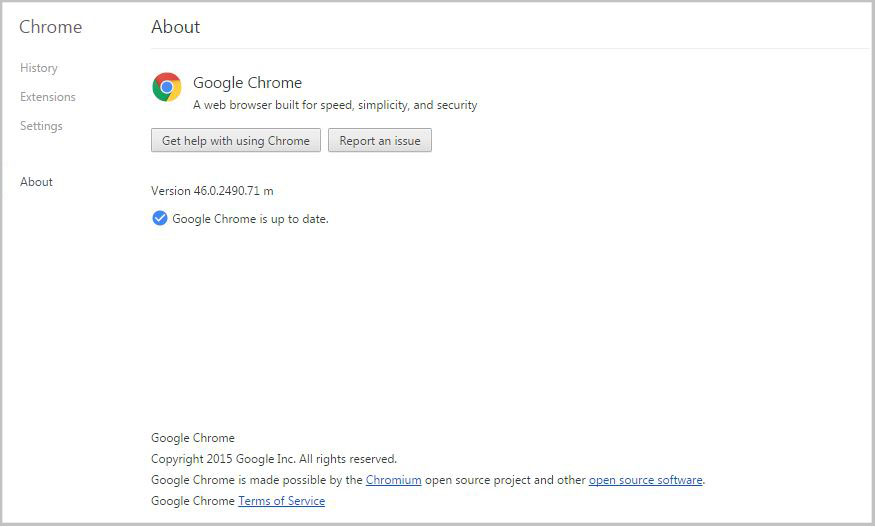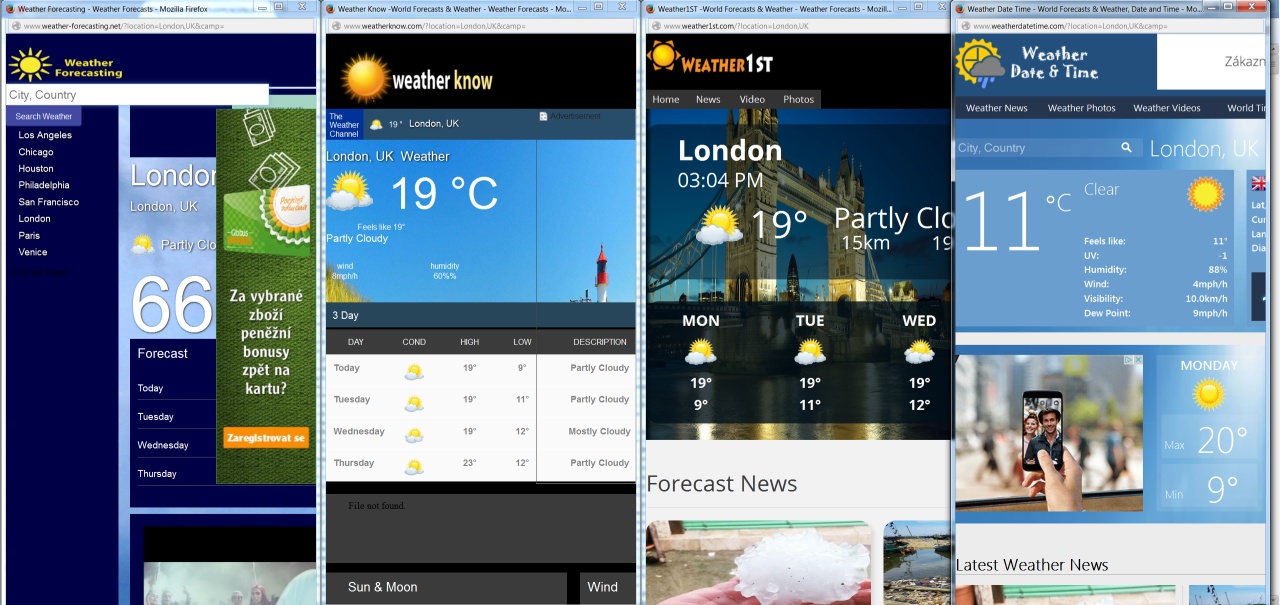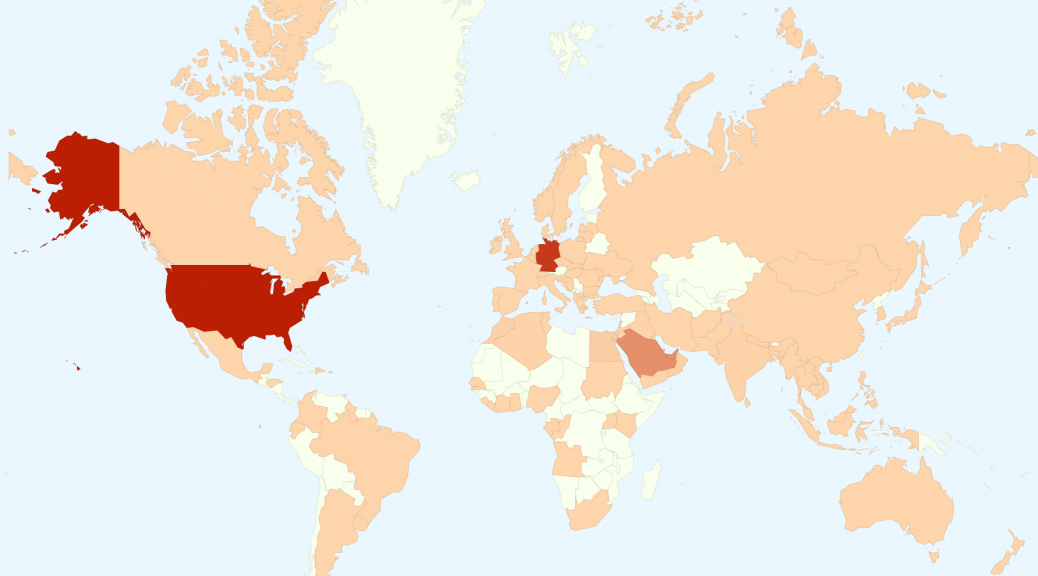Google joined the Patch Tuesday parade with a Chrome update that patches seven vulnerabilities in the browser. It also announced it was extending Safe Browsing protection to Chrome for Android.
Tag Archives: chrome
Google Ends Chrome Support on 32-bit Linux, Releases Chrome 47
Google released Chrome 47 this week and announced that it will end Chrome support for older, 32-bit Linux distributions early next year.
Fake Chrome browser replaces real thing and serves up unwanted ads

Is something not right with your browser, but you can’t quite figure out what?
Does your Chrome browser seem a little “off”, but you can’t figure out why? Maybe it’s eFast.
Here’s another reason to slow down when installing software, especially free software. A new Potentially Unwanted Program (PUP) disguised as the Google Chrome browser is sneaking onto users computers bundled with legitimate software, hidden deep within the ‘Custom’ or ‘Advanced’ settings that most people skip over. Once installed, eFast, as it has been called, serves up ads and tracks your online activities and sells personally identifiable information to advertisers.
“Read the installer screens to make sure what they actually install,” warns Michal Salat, researcher in the Avast Virus Lab. ” The Next->Next->Next->Done approach is exactly why we deal with PUPs daily. If there isn’t an option not to install some additional software, terminate the installer immediately. Better safe then sorry.”
Researchers at Malwarebytes says that eFast actually installs a new browser rather than hijacking your existing one. If you already have Chrome installed, it will replace it making itself the default browser. The fake browser uses the same source code for the user interface as the real thing making it difficult to tell the difference. It is so tricky that it even replaces shortcuts on your desktop that look similar to Google Chrome.
In addition to all that, eFast hijacks some file associations, so that it can open as many times as possible therefore having the opportunity to show you more ads! If you open a file like JPEG, PDF, or PNG, it will be opened with eFast, resulting in pop-ups, more ads in your searches, and other adware. You can see the list of file associations on Malwarebytes security blog.
How to find out if eFast is on your computer
Open your browser and type in chrome://chrome. The authentic Chrome browser will take you to the ‘About’ section and check if your browser software is up-to-date. It looks like this.

If you have a fake version of Chrome, then you will be taken to a fake About page, get an error, or the link won’t work. In that case, check out the removal instructions on PCrisk.
eFast is classified as a Potentially Unwanted Program, also known as a PUP. PUPs are annoyances like search bars, intrusive adware, etc. that Avast does not detect by default. However, the option can be enabled.
How to turn on PUP detection in Avast
- Open the Avast program and go to settings
- Open Active Protection
- Click Customize next to Web Shield
- Go to Sensitivity and put a check mark beside PUP and suspicious files
Follow Avast on Facebook, Twitter, YouTube, and Google+ where we keep you updated on cybersecurity news every day.
![]()
Weather Forecast for Today? Advert Flood Coming from East
Despite blocking efforts, online advertising is a daily part of our lives. Most of us get used to the large volume of adverts displayed daily, but authors of malicious code are trying to push the limits much further nowadays via advert-injection techniques used in malware threats.
Spreading
In this post, we present a case study of one such malware that we detected via our AVG Identity Protection (IDP) component. Based on our telemetry, this infection is highly active and it is reaching its maximal peak. The most affected countries are the United States and Germany, followed by Saudi Arabia and the United Arab Emirates.

Behaviour of This Threat
The user infection starts while installing an application proclaimed by its authors as a “Weather Forecast Application”. However, once installed, this application silently downloads and installs other components that are purely malicious – this threat tries to infect all installed browsers and inject additional adverts in browser pages. It also periodically loads sets of adverts in the background without user notification. As a side-effect, it sacrifices security and performance of the infected systems for the purpose of making money via ad providers.


Detailed Analysis
Details about this threat are described in the following technical analysis.
You can also download the report now.
Stay Safe
AVG customers are protected against this threat via our multi-level protection in AVG Internet Security. If you’re not protected, you might want to check your systems using the indicators of compromise (IOC) listed in the aforementioned technical analysis.
![]()
![]()
Google, Mozilla, Microsoft to Sever RC4 Support in Early 2016
Google and Mozilla today announced they’ve settled on a timeframe to permanently deprecate the shaky RC4 encryption algorithm.
Google to Pause Flash Ads in Chrome Starting Next Week
Google on Tuesday will begin pausing Flash ads by default in Chrome, a move that is designed mainly to help improve browser speed, but that will also be a security upgrade for users. The company announced the plan back in June and said this week that it will make the behavior the default setting for […]
Google, Chromium, HotWord, and our Avira browser
Google added a cool feature to chrome. It is voice search. They just forgot to ask the users before doing so.
The post Google, Chromium, HotWord, and our Avira browser appeared first on Avira Blog.
New Chrome Extension Helps Combat Keyboard Biometric Profiling
A new Chrome extension called KeyboardPrivacy injects delays into typing patterns, thwarting attempts to build biometric profiles of users for authentication.
Avira’s Secure Browser: Plans and Tactics (Part 2)
The goal with the browser is to create an easy-to-use, secure and privacy respecting browser. These are the more advanced tactics we will be using:
Our Cloud DBs
Adding cloud features to file scanning was a large success. The detection quality of malicious files went straight up. Short:
On the client there is a behaviour detection kind of pre-selection. If a file is suspicious the cloud server is asked if the file is already known
If unknown:
- An upload is requested
- The file is uploaded to the server
- There we have several detection modules that cannot be deployed on the customers PCs (an AI with a large database, sandboxes for behavior classification, etc. ). They scan and classify the file
- The database is updated
- The results are sent back, you are protected
We built incredible databases covering malicious files during the last years. We should have something similar for the browser and use our large knowledge base and server side classification tools for web threats as well.
It should look something like that:
- The browser detects something strange (“behavior detection”), this is called pre-selection
- It asks the backend database if this is already known
- If not: relevant data (URL, file, …) is uploaded for inspection
- Our server based tool (and our analysts) will classify the upload and update our databases
- The result is sent back directly (within milliseconds. Yes, the tools are that fast. We will try to improve our analysts
 )
) - You are protected
- We are improving our “evil parts of the internet” map.
To get there we will have to improve the signal-to-noise ratio. We are only interested in malicious pages. If the pre-selection in the browser is too aggressive and sends non-malicious pages to us, it‘s a waste of CPU cycles and bandwidth. With millions of users as a factor, even minor slips will be expensive and annoying for everyone involved.
We will also remove private data before sending it (we are not interested in user data. We are spying on malware). Personal data is actually toxic for us. Servers get hacked, databases stolen, companies gag-ordered. Not having that kind of data on our servers protects us as well as you. I mean just think of it: Some web pages have the user name in the URL (*/facepalm*). I do not think we can automatically detect and remove that trace of data though. But maybe we could shame the web pages into fixing it …*/think*
The parts in the source that collect the data and prepare them for sending are Open Source. Here I am asking you to NOT trust us and review the code! 
I hope we find a simple solution to display the data being sent to us before sending. The only problem is that it could have a negative impact on your browsing experience. Having a modal dialog when you expect a page to load …
One option could be to at least offer a global configuration to switch cloud requests off (always, in incognito mode only, never) and show you in logs what got sent.
You want your own AV? Or protection technology in your Tetris game to make it unique? Just contact our SI department and make a deal.
Other companies have thousands of web-crawlers simulating user behavior to identify malware.
Millions of real Avira users are our scouts and sensors.
Some branding
We need some branding. That would include Avira specific changes in the browser (names, logos, some other texts). But also links. This is not only relevant for brand-awareness but also to keep our users away from Chrome/Chromium support to avoid confusion (“Which Chrome version do you have ?” … listens … “we never released that, can you please click on “about and tell me the version number” … listen … “WTF?!?” => Confusion) and direct them to our support – who actually CAN help.
Hardening
We will always improve the build process. There are compiler switches for features called Position Independent Executable (PIE), Fortify Source, etc. that we should enable on compilation (many are already enabled). Most time here will be spent on ensuring that they do not get disabled by accident, are enabled on all platforms, and do not slow down the browser. This task can start simple and suddenly spawn nasty side effects. This is why we need TestingTestingTesting.
TestingTestingTesting
Google added the Hotwords feature to Chromium and Chrome. It’s a nice feature. But it switches on the microphone and “spies” on the user (this is a convenience feature many users want). For our secure and privacy respecting browser this crossed a line though. This is the reason why we will have to verify that no “surprise !!!”-Extensions get installed by default. One more task for our testers that add verification tasks to the browser to handle our specific requirements. Keep in mind: Chrome and Chromium already have very good unit-tests and other automated test cases. We just need some extra paranoia. That’s the job for our testers in the team.
More transparency
We will write blog posts covering all the features. The attacks they block, their weaknesses, what we did and will be doing to improve them. We will offer you a guided tour Down the Rabbit Hole. Go with us as far as you dare.
TL;DR:
There is so much we can do to improve the browser; without touching the core.
We reached the bottom of this specific Rabbit Hole.
Thorsten Sick
#content .entry-content
.bq{width:100%;border:1px
solid #dde5ed;margin-top:0px;margin-bottom:25px}#content .entry-content
.quest{margin:0px;font-weight:bold;font-size:16px;text-shadow:0px 1px 0px #f8fafb;padding:6px
11px;background:#eaeff5;border-top:1px solid #f4f7fa;border-bottom:1px solid #dde5ed}#content .entry-content
.text{line-height:19px;margin:0px;padding:10px;font-size:14px;background:#f8fafd;color:#758fa3}#content .entry-content .text
p{line-height:19px;background:#f8fafd;font-size:14px;color:#758fa3}
The post Avira’s Secure Browser: Plans and Tactics (Part 2) appeared first on Avira Blog.
Avira’s Secure Browser: Plans and Tactics (Part 1)
The Gordian knot
In order to have a secure browser, security issues have to be fixed in a certain time frame. This sounds logically, right? For us that’s only a few days after we get to know about them. Chrome fixes vulnerabilities with every release, so we are also forced to release in sync with the Chrome releases. But every change we make in the Chromium source code causes merge conflicts. When changes made by us (and which are Avira specific) and changes made by Chromium developers overlap our tools cannot combine them together. After about 150 changes we had one conflict per week. This meant spending hours untangling code.
The sword to slice through the knot: We will not introduce differences to the Chromium code.
Let’s see the browser more like a Linux distribution (Ubuntu, for example). We select the best tools. Combine them. Maintain them. Optimize them.
Open Source Extensions
There are awesome security extensions for browsers out there. Let’s just invest some man-years, copying their features. We can make closed source versions of those extensions which are almost as good as the original – but OURS!
… just kidding …
We decided to say ‘hello’ to the communities and explained our plans to them. We already started to contribute and will contribute even more (we struggled with the foundation for the browser longer than expected, so we are a bit behind the original time frame – but more about that in another post). The first extensions are integrated, more are upcoming and planned. Efficient engineering. A win-win situation.
Contributing to Chromium
Only code differences between our browser and Chromium cause issues. If we want a security feature and contribute the code to Chromium we do not have differences nor merge conflicts. We accidentally protect more people than we have to, but nobody is perfect. 
We already did contribute a stash of changes that allow simpler branding (see below). But the HTTPS-Everywhere guys alone have a wish list of 2-3 large Chromium code changes. Our next steps will be to extend the extension programming interface (API) because we want more information available in the extensions. For example right now the encryption details (used cypher suite, Certificates) cannot be seen from an extension. That means that something like Calomel cannot be written for Chrome so far.
Contributing to 3rd party code
Chromium contains more than 100 third party libraries. They can contain vulnerabilities, bugs and flaws. When we find something we fix it and send the patches upstream (= to the authors). We are currently experimenting with the best way to release as many fixes per week as possible. As soon as we have figured out a good solution, we will inform you via another blog post.
Our own extensions
Of course we already integrated ABS (Avira Browser Safety) and our Safe Search. This is a no brainer. So let’s just move on.
Our external tools
Right now we plan on integrating our AV scanner into the browser. We already scan with the WebGuard, but the future of the internet is encryption (more HTTPS, o/). Webguard is a proxy, and scanning encrypted traffic with a proxy causes lots of crypto-headache. Luckily the browser does decrypt the data (it has to) as soon as it gets there: Scanning the content of the decrypted data packages directly inside the browser solves said crypto-headaches.
As of now WebGuard is fine. But of course we already plan for the future. When the future is here we will be ready – with scanning abilities in the browser.
This above are only about 50 % of what we plan on doing. Stay tuned for two more and rather advanced tactics that we plan on using and which will be described in the next blog post!
TL;DR:
There is so much we can do to improve the browser. Without touching the core.
Halfway down the Rabbit Hole. Time for a break.
Thorsten Sick
The post Avira’s Secure Browser: Plans and Tactics (Part 1) appeared first on Avira Blog.
